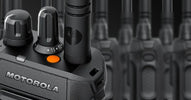
Troubleshooting Bluetooth Connectivity on Motorola Radios
, by Joseph Gabriel, 5 min reading time

, by Joseph Gabriel, 5 min reading time
Reliable Bluetooth performance is a major part of keeping operations smooth, especially when users depend on wireless gear for communication. Bluetooth connection problems can slow down operations and create communication breakdowns in the field. When a Motorola radio won’t pair with headsets, speakers, or other devices, productivity drops, team coordination becomes harder, and safety concerns rise. Fortunately, troubleshooting Bluetooth connectivity on Motorola radios is easy if you know what to do. This guide walks through practical steps that get wireless connections working again. Follow the steps to address the root cause of your communication pairing issues.
Before diving into settings or hardware checks, confirm that your Bluetooth accessory is compatible with the radio. Motorola radios support specific Bluetooth versions and profiles. If the headset or speaker doesn’t meet those standards, it won’t connect properly, if at all.
Look through your radio’s manual for a list of supported accessories and Bluetooth profiles. Some older devices may not support the required technology, especially if they use outdated Bluetooth protocols. Switching to a recommended or newer accessory that matches the radio’s technical specs often fixes pairing issues right away.
Low battery levels can limit or disable Bluetooth functions. When the battery drops below a certain point, some radios reduce transmission strength or turn off Bluetooth to conserve power.
Always check the battery status when troubleshooting wireless issues. Recharge or swap in a fully charged battery before assuming the problem lies elsewhere. Some radios won’t even attempt Bluetooth pairing if the power level is too low. Keeping backup batteries nearby can save time when working in the field.
Pairing steps vary between different Motorola radio models. It’s not always as simple as turning Bluetooth on and connecting. Some radios require a specific sequence of button presses or menu selections to complete pairing.
Start by removing previous pairings on both the radio and the accessory. Then, follow the correct pairing steps for your specific model. Motorola R7 accessories, for example, often use a different pairing mode than regular consumer devices. Always follow the manufacturer’s pairing instructions closely.

Bluetooth settings can become corrupted over time, which could cause failed connections or dropped signals. A fresh start can fix many software-related pairing problems.
Most professional-grade Motorola radios include a Bluetooth reset option or allow you to clear the paired devices through the settings menu. This is especially useful in field environments when you are using multiple radios because pairing problems can greatly slow down operations.
Returning to default settings usually takes less than a minute to complete. After the reset, you’ll need to re-pair any previously connected accessories. It’s a good idea to jot down what the device pairings are before doing the reset.
An outdated firmware version is a common cause of Bluetooth problems. New firmware updates usually fix bugs, improve stability, and expand compatibility with newer accessories.
Check Motorola’s official site for updates. You’ll need to know your radio’s model number and may need a USB connection and Motorola programming software to complete the update. Try to schedule firmware updates during a time when the radio isn’t in active use since the process will disable functions temporarily. Afterward, Bluetooth connectivity is likely to become more stable.
Even if the radio pairs correctly, outside interference can still disrupt the Bluetooth signal. Devices that run on the same 2.4 GHz frequency, like Wi-Fi routers, smartphones, and even microwave ovens, can interfere with Bluetooth signals.
Move the radio away from other electronics, especially when you’re testing connections. Large metal objects and concrete walls also weaken signals. Try using the radio and accessory in an open area to rule out signal blockages. Identifying and removing interference sources makes it easier to spot the real issue.

Sometimes, everything appears connected, but no sound comes through the Bluetooth device. This could be an audio routing issue. Radios often default to internal speakers unless manually set to use Bluetooth audio.
Go into the audio settings and check where the sound is routing to. Also, verify that the volume is high enough to hear on both the radio and the accessory. A muted radio setting can make it seem like the devices aren’t working properly when, in fact, they are.
Sometimes the issue lies with the accessory, not the radio. A faulty Bluetooth headset or speaker may prevent pairing even if the radio is functioning correctly.
To isolate the problem, test the radio with another Bluetooth device. If the new device pairs successfully, the original accessory may be the cause. Keeping a few backup accessories around makes it easier to troubleshoot by comparison.
Physical damage can block Bluetooth signals. Bluetooth radios rely on internal or external antennas, and if those components are loose, corroded, or damaged, the connection can suffer.
Check the antenna connection points and surrounding areas for signs of wear, especially if the radio has been dropped or used in harsh environments. External antennas need secure, clean connections. Moisture buildup can also create signal problems.
Under ideal conditions, Bluetooth connections typically work best within 30 feet. If you’re too far from the radio or moving in and out of range, the signal can drop.
Check the signal strength if your device has an indicator. Test in close range first to verify the connection, then slowly move farther away to see when the connection weakens. Don’t expect Bluetooth to work reliably through thick walls or in signal-heavy areas unless the environment is well-suited for wireless use.
If Bluetooth issues continue after trying these steps, professional support may be the best option. At Atlantic Radio Communications, we work with Motorola radio systems and can dig deeper into issues that resist basic fixes. Our team understands how different components interact and can troubleshoot Bluetooth connectivity on Motorola radios with accuracy. Contact Atlantic Radio Communications to schedule a consultation today.


